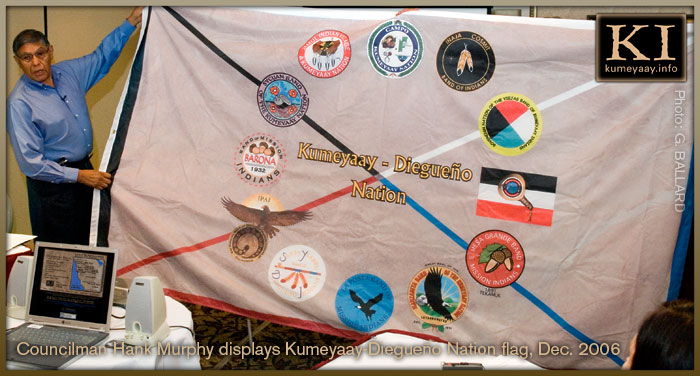|
The Kumeyaay tribe map:
Diegueño, Iipay-Tiipay, Mission Indians, Kumiai aboriginal tribal bands of the U.S.-Mexico border region
The Kumeyaay have been categorized within the so-called Hokan Delta-California group of the Yumans.
600 GENERATIONS in San Diego!
Español | 中文 | 日本 | Française | Italiano | Deutsch | 한국어 | Россию | پارس
Complete list index of the federally-recognized Kumeyaay bands of the Kumeyaay Nation, an Indigenous tribe of Southern California, Southwestern region of the United States -- includes the four Kumiai ejidos (tribal community ranches) of Baja California Norte located on the Mexico-U.S. border region.
Kumeyaay Bands of the United States
in the 21st Century:

KUMEYAAY MAP of the current Kumeyaay Indian reservations and territories -- FREE MAP DOWNLOAD royalty-free for education and non-profit use.
12 Kumeyaay bands -- 13 Kumeyaay Indian reservations
Southern California Kumeyaay bands, featuring 13 federally-recognized sovereign Kumeyaay Indian reservations. Official websites: Locate each band's website for Internet access to their Kumeyaay band's perspectives directly from their tribal archivists and historians:
- Campo Band of the Kumeyaay Nation
- Viejas Band of Kumeyaay Indians
- Barona Band of Mission Indians
- San Pasqual Band of Indians
- Inaja Cosmit Indian Reservation
- Capitan Grande Indian Reservation
- Santa Ysabel Band of Diegueño Indians, aka Iipay Nation of Santa Ysabel
- Ewiiaapaayp Band of Kumeyaay Indians aka Cuyapaipe
- Manzanita Indian Reservation
- La Posta Indian Reservation
- Jamul Indian Village A Kumeyaay Nation
- Mesa Grande Band of Diegueño Mission Indians
- Sycuan Band of the Kumeyaay Nation
Our exclusive map of the Kumeyaay bands pinpoints the current tribal regions of the Kumeyaay American Indian tribe.
The Kumeyaay are believed to have occupied this general area for some 12,000 years.

Visit our Kumeyaay History and timeline to learn information about Kumeyaay language, culture, featuring historical and contemporary photographs, scholarly research articles and essays about ethnographic studies concerning the Kumeyaay people's right to sovereign self governance as Southern California's original aboriginal inhabitants.
HOW TO CONTACT THE TRIBAL BANDS:
Visit the SOUTHERN CALIFORNIA TRIBAL CHAIRMEN'S ASSOCIATION SCTCA for more complete information about the Native American Indian reservations in Southern California, including their leadership, official websites, contacts, phone numbers, addresses, cultural and businesses background summaries.
For similar information about the tribal bands of California -- Northern, Central, Southern -- vist the CALIFORNIA TRIBAL CHAIRPERSON'S ASSOCIATION.
|



